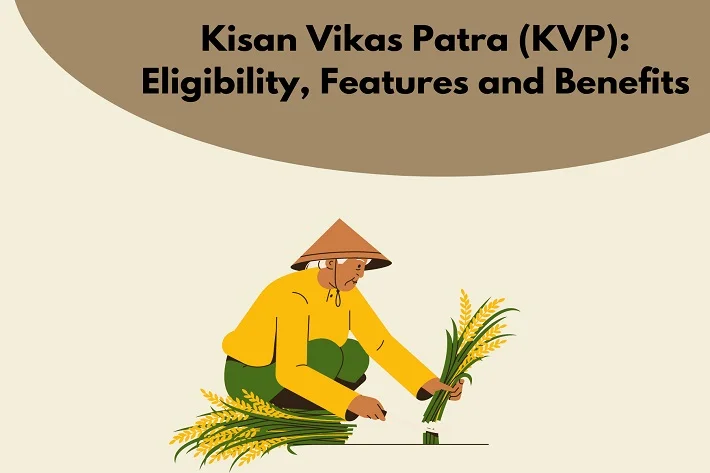Within the range of investment options the Indian government has encompassed in its scheme of things, Kisan Vikas Patra (KVP) appears as the frontrunner choice. Adjusting to reflect rural and semi-urban saver’s savings requirements, KVP proved to be a secure and remunerative method that was great for wealth growth. In 1988, Kisan Vikas Patra, a KVP certificate scheme for small savings conducted by India Post, became a project of the Ministry of Finance. This institution’s first instance was created to make long-term savings more appealing and encourage the citizens to accumulate wealth rather than spend it. To start with, the scheme was designed for farmers. But now, everyone who has met the requirement can benefit from it.
The article is supposed to cover Kisan Vikas Patra, in the same way, let’s discuss the details.
Read more: Pradhan Mantri Awas Yojana
What is Kisan Vikas Patra (KVP)?
Kisan Vikas Patra (KVP), which is a post-office-operated certificate scheme allowing individuals to save and invest for the long term, is yet another investment scheme that is promoted by the Indian government as part of their push to reserve saving and investment. An offering of an investment scheme that promises to double your investment under a coin-toss (heads you win, tails you lose) scheme with a fixed return over a given period appealing to those who have a conservative risk appetite and extra funds for guaranteed returns.
Well, the Kisan Vikas Patra Scheme is one of this class of investors including public sector banks and India Post Offices. An account opening of KVPs needs a deposit of at least a thousand rupees where further contributions can be made in multiples of a hundred rupees. Significantly, the upper limit for the maximum amount deposited per account, or account holder, is not specified, which greatly lends to the level of influence investors have over their funds.
Types of Kisan Vikas Patra
Kisan Vikash Patra is an investment scheme that provides saving certificates in three different types:
- Single Holder Type Patra: This certification is only restored to legal adults either for personal or minor benefit.
- Joint A Type Patra: Under this category, it will be available to two adults also in the name of Jointly Kisan Vikas Patra. Only one of the beneficiaries is allowed to receive the lump sum stated in the will, thus avoiding disputes regarding its distribution.
- Joint B Type Patra: The owner has a choice: they can either own it jointly with another person, or they can name the secondary holder. After the death of one, the survivor gets the right to the payment, be it to the owner or the secondary holder.
Eligibility for Kisan Vikas Patra Scheme
The prerequisites of KVP are illustrated below:
- The investor must hold Indian citizenship.
- The investor must be at least 18 years old.
- An adult can apply on behalf of a minor or an individual of unsound mind.
- Hindu Undivided Family (HUF) and Non-Resident Indians (NRIs) are not permitted to invest in KVP.
Required Documents for Kisan Vikas Patra Certificates
Some documents need to be produced for the issuance of Kisan Vikas Patra certificates:
- Identification Proof (such as an Aadhaar Card, Voter ID, PAN, Passport, or Driving License) for the KYC process.
- Fully completed KVP application form.
- Date of Birth certificate.
- Address Proof.
Benefits of Kisan Vikas Patra
KVP, Kisan Vikas Patra, is a scheme that allows individuals to invest their money and gain interest at an annual rate of around 7.6%:
1. Flexible Investment Options
Kisan Vikas Patra comes in a variety of denominations, ranging from Rs. 100 to Rs. 50,000 which means the investors have ample time to choose the denomination that matches their financial ability and the investment purpose.
2. Government-Backed Security
Considering Kisan Vikas Patra as a governmental scheme, investors are assured of getting their value back along with some interest in a fixed time frame. This brings in a sense of safety in such investments.
3. Risk-Free Investment
Investors will enjoy the unalterable opportunity as will be able to predict the interest rate that will prevail during the entire year, a thing that would be difficult to attain when investing in stock markets where the value of shares is on the rise or decline without previous warnings or notice.
4. Unlimited Investment Potential
Unlike some investment choices, the KVP, as long as there is no upper limit on the sum that can be invested, is available to anyone who wants to make the most of their money by investing conveniently according to their financial possibilities and goals.
5. Premature Withdrawal Flexibility
KVP offers a premature withdrawal option after the lock-in period of 2 years and 6 months which gives investors the flexibility to liquidate their shares if they have any urgent financial needs or if they are in a sudden or unforeseen event.
6. Transferability
Investors can transfer their Kisan Vikas Patra to another eligible person, with proper documentation and submittal and approval in the post office that handles the wealth continuity and inheritance planning matters.
7. Tax Benefits
Although the plan brings no tax benefits, the investors in KVP are tax-exempted beyond the final maturity date and TDS does not apply to any of their withdrawals. As a result, KVP is a profitable proposition for investors who wish to maximize their savings in the long term.
Read more: 5 Investing Tips And Guide For Beginners
Steps for Investing in Kisan Vikas Patra
The process of cluing up on and investing in Kisan Vikas Patra is given hereby:
1. Application Form Collection and Filling (Form A)
Firstly, you need to obtain Form A from the post office or bank branch where you have a posted box or deposit account. Guarantee that all areas of the template are correctly completed with the required personal information and investment characteristics.
2. Form Submission
The next step afoot is to fill in the form and pass it to the specified governmental agency at the desired post office or bank. Be careful to check if there are any required signatures or any more documents you may need to operate the system.
3. Agent Investment (Form A1)
For those instances wherein the investment is done by an agent through Form A1, the form should be appropriately filled out by the agent adhering to the guidelines stated. On digital platforms, sharing these forms will provide more convenience, taking one step further by allowing investors to initiate the particular process no matter where they are.
4. KYC Documentation
Know Your Customer (KYC) process is a step that is inherent to compliance with the regulations. Provide Primary Copies of identification and address Proof documents, like PAN card, Aadhar card, Voter’s ID, Driver’s License, or Passport, to make the verification process better and more convenient.
5. Deposit Submission
Once you pass the documents’ checking, you are free to deposit the money as per the investment deposit amount you have chosen. Cash, wire transfers, or payments executed locally through the use of cheques pay orders, or demand drafts are among the accepted methods To avoid delays, the payment must be made to the postmaster who is in charge or to the relevant authority.
6. Receipt of KVP Certificate
Right after the investment is complete, I will mail the certificate to the customer. Observe, however, that immediate issuance is a norm of the transfer unless the payment is either via cheque pay order or demand draft which may extend the time of processing. Since the certificate will be vital for remuneration, hence, keep it securely. To make things even easier, seek an electronic delivery of the certificate by email, rather than paper, in case of such an option, to obtain easy handling and management.
Read more: LIC New Bima Gold Plan 179 Maturity Calculator
Transferring a Kisan Vikas Patra Account
The account holder should make a request in writing at the post office to the post office for the delivery of the Kisan Vikas Patra certificate from one person to another. The transfer of the KVP certificate is permissible in the following scenarios: The transfer of the KVP certificate is permissible in the following scenarios:
- Due to a shifted ownership, assets can be transferred from one person to another under the mandate of the court.
- Initiated from being the only login holder to a collective sign-on of more than one person.
- I can withdraw the funds from it in case the joint account holder doesn’t have access to it.
- Acquisition by an heir of the KVP certificate in their title in case of death of entitled person.
What is The Interest Earned on KVP?
The Kisan Vikas Patra (KVP) interest rate is subject to this type of change. Usually, the Ministry of Finance releases the corresponding announcements regarding these changes. Currently, the KVP rate is 7.5% per year and it is valid from 30th June 2022 to 29th June 2023 (Q4 FY 2023-24). If the current trend goes, your investment will double in just under 10 years.
Conclusion
The Kisan Vikas Patra (KVP) is a very appealing type of investment option for those saving up for safety and a high base rate of interest with a long-term vision. Generally, KVP offers a sound investment vehicle to consumers who want to invest their money to enjoy the wealth-building margin traditionally through various advantages and transferability options. Nonetheless, you have to keep up with any fluctuations in the interest rate of KVP, which may greatly affect returns and then need to do your homework well before committing to any investment.



